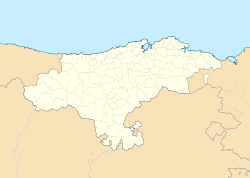
Cantabria is an autonomous community in northern Spain with Santander as its capital city. It is called a comunidad histórica, a historic community, in its current Statute of Autonomy. It's bordered on the east by the Basque autonomous community, on the south by Castile and León, on the west by the Principality of Asturias, and on the north by the Cantabrian Sea.

This is a list of the 50 largest cities in the Americas by population residing within city limits as of 2015, the most recent year for which official population census results, estimates or short-term projections are available for most of these cities. These figures do not reflect the population of the urban agglomeration or metropolitan area which typically do not coincide with the administrative boundaries of the city. For a list of the latter, see List of metropolitan areas in the Americas by population. These figures refer to mid-2015 populations with the following exceptions:
- Mexican cities, whose figures derive from the 2015 Intercensal Survey conducted by INEGI with a reference date of 15 March 2015;
- Calgary, whose 2015 municipal census had a reference date of April 1.
- Brazilian Cities, whose figures originate from the 2021 estimate given by the IBGE, with a reference date of July 1st, 2021.

The Cantabria autonomous football team is the regional football team for Cantabria, Spain. They are not affiliated with FIFA or UEFA and therefore are only allowed to play friendly matches.

Talamanca is a canton in the Limón province of Costa Rica. The head city is Bribri, located in Bratsi district.

Immigration to Spain increased significantly in the beginning of the 21st century. In 1998, immigrants accounted for 1.6% of the population, and by 2009, that number had jumped to above 12% — one of the highest in Europe at the time. Until 2014, the numbers were decreasing due to the economic crisis, but since then, immigration to Spain has increased again since 2015.

Miguel Ángel Revilla Roiz is a Spanish politician, economist and bank employee serving as the 9th President of the Autonomous Community of Cantabria. Before this, Revilla has served as the 7th President between 2003 and 2011, making him the longest serving holder of the office. He has also served as the 5th Vice President of Cantabria from 1995 to 2003 and regional Minister of Public Works, Housing and Urbanism in the same period.
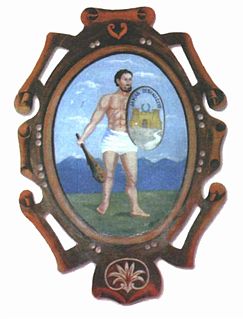
Huanta is a town in Central Peru, capital of the province Huanta in the region Ayacucho.
Russians in Spain form one of the country's smaller foreign communities, making up about 0.83% of all foreigners in Spain.

Valle de Villaverde is a town and municipality in the autonomous community of Cantabria, Spain. It is surrounded by the Basque municipalities of Carranza, Arcentales, and Trucíos, but the town belongs to the administration of the government of Cantabria. Thus, it is an enclave of Biscay and an exclave of Cantabria.
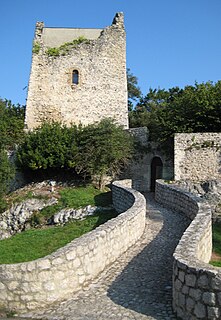
Val de San Vicente is a municipality located in the autonomous community of Cantabria, Spain.

The 1983 Cantabrian regional election was held on Sunday, 8 May 1983, to elect the 1st Regional Assembly of the autonomous community of Cantabria. All 35 seats in the Regional Assembly were up for election. The election was held simultaneously with regional elections in twelve other autonomous communities and local elections all throughout Spain.
Italians in Spain are one of the largest communities of immigrant groups in Spain, with 228,283 Italian citizens in the country; conversely, 135,020 residents in Spain were born in Italy.
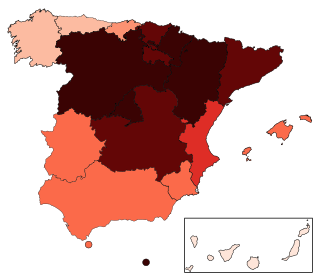
The COVID-19 pandemic in Spain is part of the pandemic of coronavirus disease 2019 caused by severe acute respiratory syndrome coronavirus 2. The virus was first confirmed to have spread to Spain on 31 January 2020, when a German tourist tested positive for SARS-CoV-2 in La Gomera, Canary Islands. Post-hoc genetic analysis has shown that at least 15 strains of the virus had been imported, and community transmission began by mid-February. By 13 March, cases had been confirmed in all 50 provinces of the country.
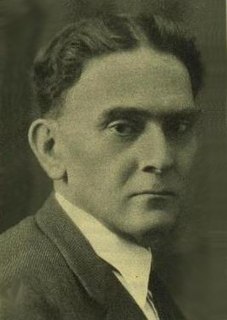
Domingo Tejera de Quesada (1881-1944) was a Spanish publisher. In 1911-1913 he managed a Madrid illustrated review Nuevo Mundo, in 1922-1939 a Seville-based daily La Unión, and during short spells also other minor periodicals. During his career he contributed to numerous other newspapers, and gained recognition as the 1914-1917 war correspondent of ABC. Politically he initially sided with the Maurista faction of the Conservatives, but later he adopted a Traditionalist posture and became one of the most vehement Carlist propagandists. His political climax fell on the period of 1933–1936, when he served within the Carlist minority in the Cortes.




